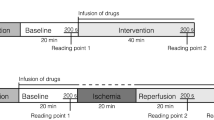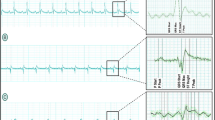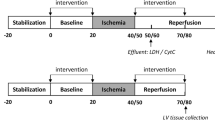Summary
As pyrroloquinoline quinone (PQQ) is a redox cofactor in mammals, we asked if it is cardioprotective. Rats were subjected to 2 h of left anterior descending (LAD) coronary artery ligation without reperfusion (model 1, ischemia). In model 2 (ischemia/reperfusion), rats were subjected to 17 or 30 min of LAD occlusion and 2 h of reperfusion. PQQ (15–20 mg/kg) was given i.p., either 30 min before LAD occlusion (Pretreatment) or i.v. at the onset of reperfusion (Treatment). In model 1, PQQ reduced infarct size (10.0 ± 1.5 vs 19.1 ± 2.1%, P < 0.01). In model 2, either PQQ Pretreatment or Treatment also reduced infarct size (18.4 ± 2.3 and 25.6 ± 3.5% vs 38.1 ± 2.6%, P < 0.01). PQQ resulted in higher LV developed pressure and LV (+)dP/dt after 1–2 h of reperfusion (P < 0.05), and fewer ventricular fibrillation episodes. PQQ dose (5–20 mg/kg) was inversely related to infarct size. PQQ reduced myocardial tissue levels of malondialdehyde (MDA), an indicator of lipid peroxidation (316 ± 88 vs 99 ± 14 nmol/g, P < 0.01). PQQ given either as Pretreatment or as Treatment at the onset of reperfusion is highly effective in reducing infarct size and improving cardiac function in a dose-related manner in rat models of ischemia and ischemia/reperfusion. The optimal dose in this study, which exhibited neither renal nor hepatic toxicity, was 15 mg/kg, but lower doses may also be efficacious. We conclude that PQQ, which appears to act as a free radical scavenger in ischemic myocardium, is a highly effective cardioprotective agent.
Similar content being viewed by others
Abbreviations
- PQQ:
-
pyrroloquinoline quinone
- ANOVA:
-
analysis of variance
- LV:
-
left ventricle
- VF:
-
ventricular fibrillation
- LAD:
-
left anterior descending coronary artery
- LVSP:
-
left ventricular systolic pressure
- LVDP:
-
left ventricular developed pressure
- MDA:
-
malondialdehyde
References
Zhang Y, Rosenberg PA. The essential nutrient pyrroloquinoline quinone may act as a neuroprotectant by suppressing peroxynitrite formation. European J Neuroscience 2002;16:1015–1024.
Xu F, Mack CP, Quandt KS, Shlafer M, Massey V, Hultquist DE. Pyrroloquinoline quinone acts with flavin reductase to reduce ferryl myoglobin in vitro and protects isolated heart from re-oxygenation injury. Biochemical Biophysical Research Communications 1993;193:434–439.
Jensen FE, Gardner GJ, Willams AP, Gallop PM, Aizenman E, Rosenberg PA. The putative essential nutrient pyrroloquinoline quinone is neuroprotective in a rodent model of hypoxic/ischemic brain injury. Neurosience 1994;62(2):399–406.
Sievers RE, Schmiedl U, Wolfe CL, et al. A model of acute regional myocardial ischemia and reperfusion in the rat. Magn Reson Med 1989;10:172–181.
Zhu B-Q, Sun Y-P, Sudhir K, et~al. Effects of second-hand smoke and gender on infarct size of young rats exposed in utero and in the neonatal to adolescent period. J Am Coll Cardiol 1997;30:1878–1885.
Zhu B-Q, Sun Y-P, Sievers RE, Glantz SA, Parmley WW, Wolfe CL. Exposure to environmental tobacco smoke increases myocardial infarct size in rats. Circulation 1994;89:1282–1290.
Zhu B-Q, Sun Y-P, Sievers RE, et~al. L-Arginine decreases infarct size in rats exposed to environmental tobacco smoke. Am Heart J 1996;132:91–100.
Zhu B-Q, Sun Y-P, Sievers RE, et~al. Comparative effects of pretreatment with captopril and losartan on cardiovascular protection in a rat model of ischemia-reperfusion. J Am Coll Cardiol 2000;35:787–795.
Zhu B-Q, Sievers RE, Browne AEM, et~al. Comparative effects of aspirin with ACE inhibitor or angiotensin receptor blocker on myocardial infarction and vascular function. JRAAS 2003;4:31–37.
Ohkawa H, Ohishi N, Yagi K. Assay for lipid peroxides in animal tissues by thiobarbituric acid reaction. Analytical Biochemistry 1979;95:351–358.
Moritz F, Monteil C, Isabelle M, et~al. Role of reactive oxygen species in cocaine-induced cardiac dysfunction. Cardiovascular Research 2003;59:834–843.
Paz MA, Fluckiger R, Gallop PM. The biomedical significance of PQQ. In: Davidson VL ed, Principles and Applications of Quinoproteins, Marcel Dekker, Inc: 1992 381– 393.
Kasahara T, Kato T. A new redox-cofactor vitamin for mammals. Nature 2003;422:832.
Gallop PM, Paz MA, Fluckiger R, Henson E. Is the anti-inflammatory putative new vitamin, PQQ, involved with nitric oxide in bone metabolism? Connect Tissue Res 1993;29:153–161.
Mitchell AE, Jones AD, Mercer RS, Rucker RB. Characterization of pyrroloquinoline quinone amino acid derivated by electrospray ionization mass spectrometry and detection in human milk. Analytical Biochemistry 1999;269:317–325.
Kumazawa T, Seno H, Urakami T, Matsumoto T, Suzuki O. Trace levels of pyrroloquinoline quinone in human and rat samples detected by gas chromatography/mass spectrometry. Biochim Biophys Acta 1992;1156:62–66.
Kumazawa T, Sato K, Seno H, Ishii A, Suzuki O. Levels of pyrroloquinoline quinone in various foods. Biochem J 1995;307:331–333.
Steinberg F, Stites TE, Anderson P, et al. Pyrroloquinoline quinone improves growth and reproductive performance in mice fed chemically defined diets. Exp Biol Med (Maywood) 2003;228:160–166.
Steinberg FM, Gershwin ME, Rucker RB. Dietary pyrroquinoline quinone: growth and immune response in BALB/c mice. J Nutr 1994;124:744–753.
Urakami T, Yoshida C, Akaike T, Maeda H, Nishigori H, Niki E. Synthesis of monoesters of pyrroloquinoline quinone and imidazopyrroloquinoline, and radical scavenging activities using electron spin resonance in vitro and pharmacological activity in vivo. J Nutr Sci Vitaminol (Tokyo) 1997;43:19– 33.
He K, Nukada H, Urakami T, Murphy MP. Antioxidant and pro-oxidant properties of pyrroloquinoline quinone (PQQ): implications for its function in biological systems. Biochemical Pharmacology 2003;65:67–74.
Miyauchi K, Urakami T, Abeta H, Shi H, Noguchi N, Niki E. Action of pyrroloquinolinequinol as as antioxidant against lipid peroxidation in solution. Antioxid Redox Signal 1999;1: 547–554.
Bishop A, Paz MA, Gallop PM, Karnovsky ML. Inhibition of redox cycling of methoxatin (PQQ), and of superoxide release by phagocytic white cells. Free Radic Bio Med 1995;18:617–620.
Bishop A, Paz MA, Gallop PM, Karnovsky ML. Methoxatin (PQQ) in guinea-pig neutrophils. Free Radic Bio Med 1994;17:311–320.
Yang Z, Berr SS, Gilson WD, Toufektsian M-C, French BA. Simultaneous evaluation of infarct size and cardiac function in intact mice by contrast-enhanced cardiac magnetic resonance imaging reveals contractile dysfunction in noninfarcted regions early after myocardial infarction. Circulation 2004;109:1161–1167.
Kramer CM, Rogers WJ, Theobald TM, Power TP, Petruolo S, Reichek N. Remote noninfarcted region dysfunction soon after first anterior myocardial infarction. A magnetic resonance tagging study. Circulation 1996;94:660– 666.
Hamagishi Y, Murata S, Kamei H, Oki T, Osao A, Ameyama M. New biological properties of pyrroloquinoline quinone and its related compounds: inhibition of chemiluminescence, lipid peroxidation and rat paw edema. J Pharmacol. Exp. Ther. 1990;255:980–985.
Dai W, Kloner RA. Effects of acetaminophen on myocardial infarct size in rats. J Cardiovasc Pharmacol Therap 2003;8:277–284.
Watanabe A, Hobara N, Ohsawa T, Higashi T, Tsuji T. Nephrotoxicity of pyrroloquinoline quinone in rats. Hiroshima J Med Sci 1989;38:49–51.
Smidt CR, Unkefer CJ, Houck DR, Rucker RB. Intestinal absorption and tissue distribution of [14C]pyrroloquinoline quinone in mice. Proceedings of the Society for Experimental Biology and Medicine 1991;197:27–31.
Suzuki O and Kumazawa T. Gas chromatographic-mass spectrometric analysis of pyrroloquinoline quinone. Methods in Enzymology 1997;280:150–158.
Author information
Authors and Affiliations
Corresponding author
Additional information
This study was supported by the Charitable Leadership Foundation
Rights and permissions
About this article
Cite this article
Zhu, Bq., Zhou, Hz., Teerlink, J.R. et al. Pyrroloquinoline Quinone (PQQ) Decreases Myocardial Infarct Size and Improves Cardiac Function in Rat Models of Ischemia and Ischemia/Reperfusion. Cardiovasc Drugs Ther 18, 421–431 (2004). https://doi.org/10.1007/s10557-004-6219-x
Issue Date:
DOI: https://doi.org/10.1007/s10557-004-6219-x




